
By Edward T. Baker, Supervisory Oceanographer - NOAA, Pacific Marine Environmental Laboratory
and Bill Chadwick, Research Professor - Oregon State University
September 20, 2012
Video showing black smoker chimneys found on the second dive at Mata Ua. Video courtesy of MARUM, University of Bremen and NOAA-Pacific Marine Environmental Laboratory. Download (mp4, 128.9 MB).
Finding the bubbling crater of a terrestrial volcano poses no problem: look for the smoke using a satellite or aircraft or even your pickup truck. Exploration of submarine volcanoes under the opaque ocean is far more challenging. Locating volcanoes starts with methodical mapping of the seafloor. Mapping a region as large as the northeast Lau Basin requires months of research voyages spaced over several years. Here in the Lau Basin we have identified scores of volcanoes over the past decade. But only a handful are likely to be actively venting at present. To locate those volcanoes we must find those surrounded by a telltale halo of chemical-laden plume waters, the residue of hot hydrothermal fluids.
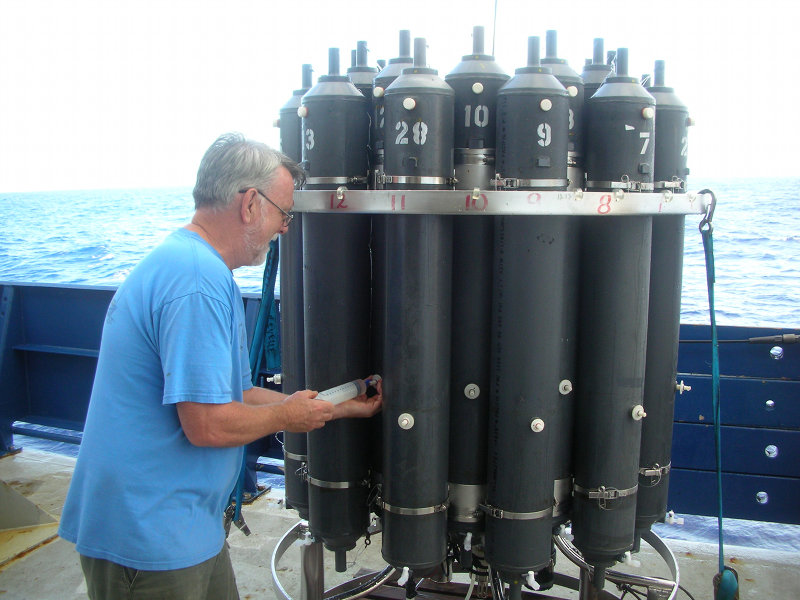
Scientist on board R/V Roger Revelle extracts water from one of the sample bottles in the CTD rosette. Image courtesy of Submarine Ring of Fire 2012: Northeast Lau Basin, NOAA-OER. Download larger version (jpg, 1.9 MB).
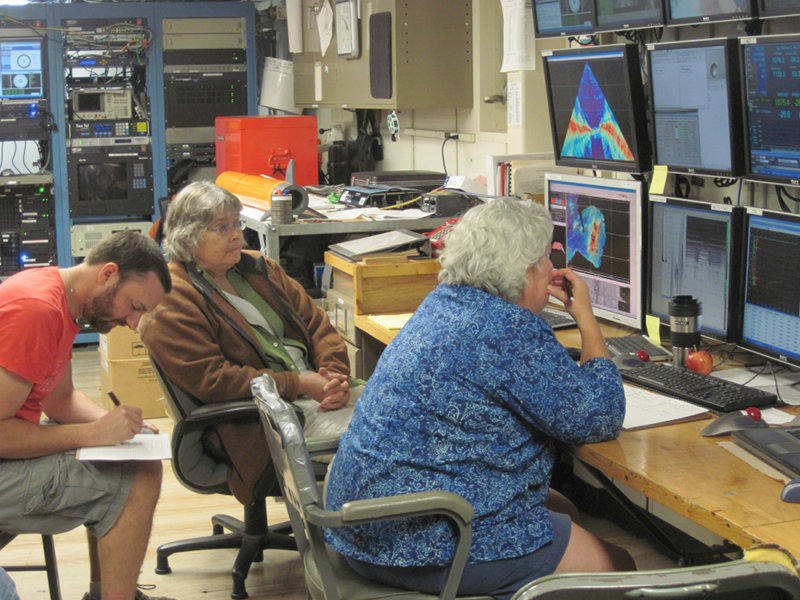
Scientists in computer lab on board the R/V Roger Revelle examine multibeam and CTD data in preparation for the second dive at Mata Ua. Image courtesy of Submarine Ring of Fire 2012: Northeast Lau Basin, NOAA-OER. Download larger version (jpg, 4.8 MB).
During surveys here in the northeast Lau Basin between 2008 and 2010, we used a CTD (Conductivity-Temperature-Depth) package to search for actively venting volcanoes. A CTD is a standard oceanographic tool for plumbing the ocean depths. Lowered on a wire with an array of sensors and sampling bottles, it telemeters to the ship the temperature, salinity, turbidity (the concentration of particles in the water), and chemistry of the seawater. Casting at each North Mata volcano, we discovered that at least five of the seven are spewing the hydrothermal fluids that support chemosynthetic ecosystems. These discoveries made this area an ideal target for our exploration of the seafloor using the Quest 4000 ROV.
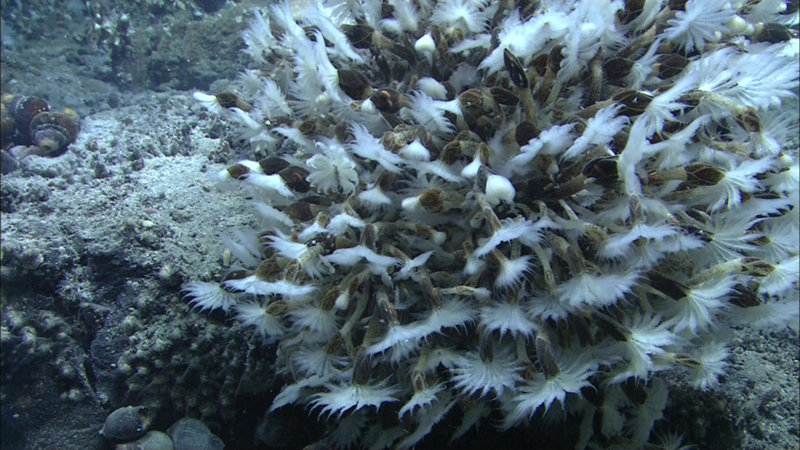
A “bush” of barnacles and other vent animals were one of the first indicators that the ROV was getting close to the high-temperature vents. Image courtesy of MARUM, University of Bremen and NOAA-Pacific Marine Environmental Laboratory. Download larger version (jpg, 901 KB).

Close-up view of the stalked barnacles filter-feeding with their white “citti“, that look like little palm fronds. Image courtesy of MARUM, University of Bremen and NOAA-Pacific Marine Environmental Laboratory. Download larger version (jpg, 139 KB).
But finding a needle-sized vent field on a volcano-sized haystack requires both experience and luck. In the Sept. 16 mission log, Dr. Richard Arculus described our first attempt at Mata Ua. Wisps of hydrothermal smoke and scuttling hydrothermal fauna tantalized the Quest 4000 team during the dive. Despite an extensive survey, no vent sites were located around the suspected site on the volcano’s summit. Imagine trying to find your tent in a forest on a perfectly black night using only a flashlight that pointed at your feet! Thinking geologically, we noticed that the north flank of the volcano appeared to be a fault scarp. Faults provide easy access for water flow, including hydrothermal fluids, in Earth’s crust. Was this an unusual volcano where the activity was not on the summit? We decided to tow the CTD package near the seafloor along the fault scarp, continually raising and lowering it to search for plumes.
Now it was luck’s turn. About an hour into the tow, a chemical sensor began detecting higher and higher concentrations of hydrothermal fluids. As we lowered the CTD to less than 25 m above the lava rubble, suddenly the temperature sensor began spiking, indicating blobs of water more than 0.3°C warmer than normal. Such a small change is insignificant on land, but totally unexpected in the cold and constant water of the deep sea. Our only explanation was that the CTD had passed directly over a vent field, intercepting the hot fluids as they rose upward to form the hydrothermal “smoke“ seen on the first ROV dive at Mata Ua.
Armed with this information, our next dive at Mata Ua descended almost precisely into a forest of both expired and venting black smoker chimneys. It was almost as easy as driving right to it in your pickup truck…
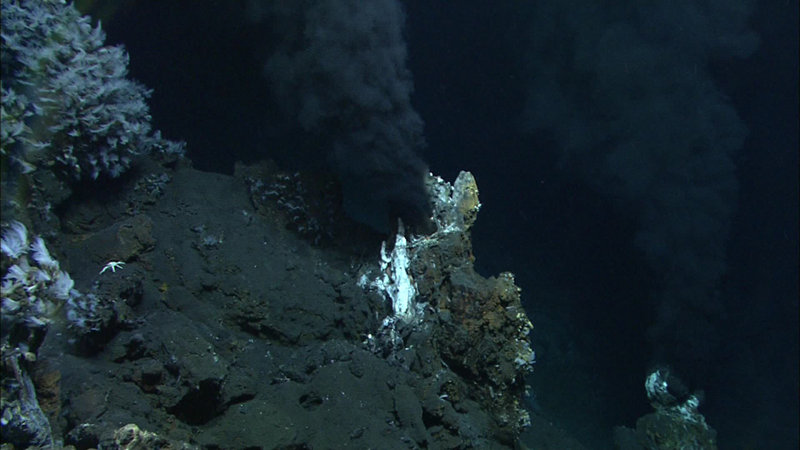
Two black smoker chimneys belch hot vent fluid up into the water column, helping to form the plume that the CTD found above the volcano. Image courtesy of MARUM, University of Bremen and NOAA-Pacific Marine Environmental Laboratory. Download larger version (jpg, 374 KB).
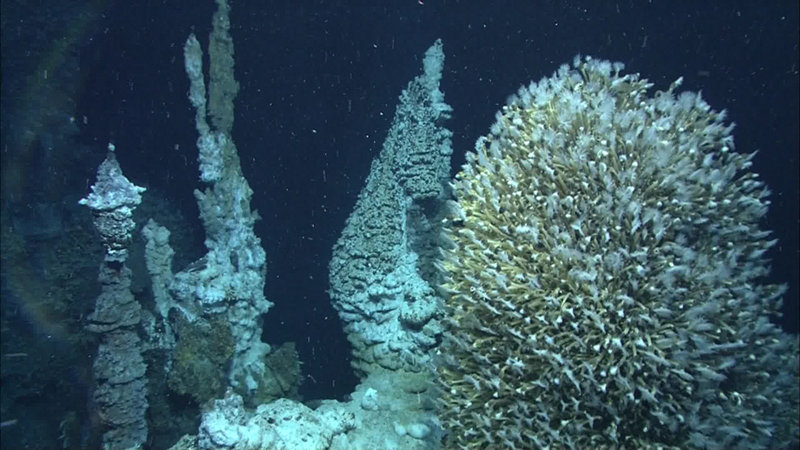
A sulfide chimney with lower-temperature venting on the right is colonized by a thick coating of vent barnacles, looking somewhat like a Christmas tree. Image courtesy of MARUM, University of Bremen and NOAA-Pacific Marine Environmental Laboratory. Download larger version (jpg, 385 KB).
We started downslope of the target identified by the CTD. Armed with more information, we now had a better idea of where to focus our exploring efforts to order to locate and sample the hydrothermal vents producing the warm water plume above the volcano. We reached the seafloor at the base of the volcano’s flank. Not much was happening there, just sediment with a few boulders that had rolled down the slope. But sure enough, as we started to move the ROV upslope, we first encountered dead snail shells, then hydrothermally-altered rocks and sediments, squat lobsters, and then suddenly thick colonies of hydrothermal vent barnacles living on the rocks. Clearly, we were getting closer and closer to the vents. Zooming the ROV’s camera into the barnacle bushes was a mesmerizing sight, watching them filter-feed with their cirri, which looked like bright white palm fronds waving in the current. Inside each barnacle colony were even smaller vent animals, including polychaetes, limpets, and shrimp.
Literally within minutes of proceeding upslope from the first barnacles, we encountered the first sulfide chimneys on the steep, northwest-facing volcano slope. The first chimneys were mildly active, but the next ones we encountered were a pair of black smokers, jetting dark smoky vent fluid. The ROV’s temperature probe measured 360°C. Clearly, we had found the source of the hydrothermal plume. As the dive progressed, we saw increasing numbers of chimneys on the slope, some venting mineral laden “smoke“, others spewing clear hot fluids. Amazingly, the barnacles were completely covering some of the less-vigorous sulfide chimneys, making them look like Christmas trees. We were all a bit frustrated after our first dive at Mata Ua, when we were not able to locate this vent site. However, given some additional valuable information and some more time to explore on our second dive, we discovered a new vent field that human eyes had never seen before. Frustration turned to elation and the satisfaction that our multidisciplinary team on this expedition worked so well together to achieve our common goal: to explore, discover, and characterize new vent sites in this wondrous and very active part of the planet.